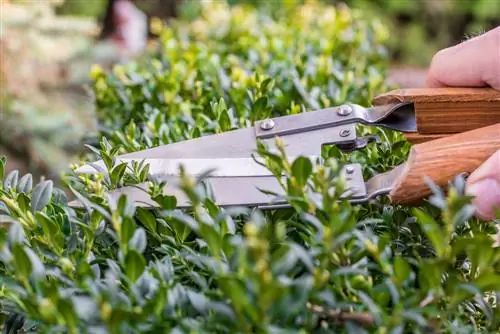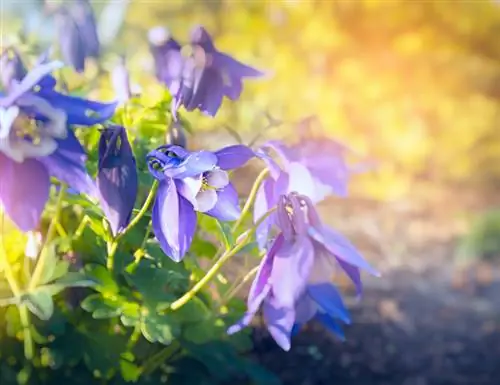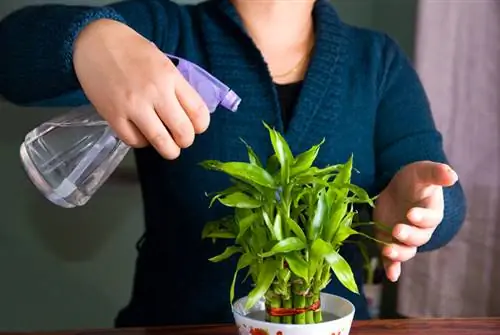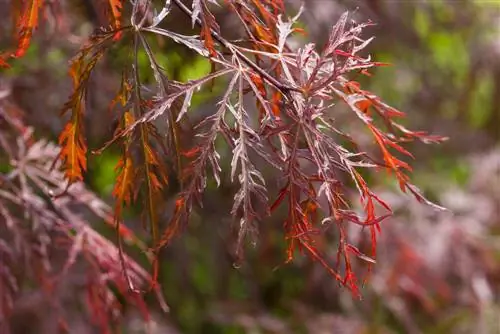- Author admin [email protected].
- Public 2023-12-16 16:46.
- Last modified 2025-01-23 11:21.
Basically, the popular, evergreen boxwood is considered easy to care for. However, its image has suffered greatly in recent years, largely due to a relatively new fungal disease and a pest introduced from Asia. In order to keep your Buchs he althy for as long as possible, it needs good care.

How do you properly care for a boxwood?
Boxwood care includes regular watering, especially in dry periods, organic fertilizer in spring and June, and pruning between April and September. Watch out for pests such as boxwood borers and diseases such as boxwood shoot dieback.
Do you have to water boxwood?
Boxwood has a fairly high water requirement and, depending on the variety, is rather less tolerant of heat and drought. It is therefore preferable to plant the tree in fresh soil to avoid constant watering in summer. In very dry and/or hot phases, regular watering is also important for specimens that have been planted in the garden, as well as for freshly planted boxwoods. These should be watered for the first three to four weeks after planting. Always water from below, never over the leaves and use hard tap water.
When and with what should you fertilize boxwood?
The box does best with organic fertilizer, such as a mixture of mature compost, horn shavings (€52.00 on Amazon) and primary rock powder. This is applied twice a year, once for budding in spring and once in June. Lime fertilization can also be carried out if necessary. However, you should refrain from using coffee grounds, blue grain, etc. because of their unfavorable nutrient composition for boxwood.
What is the best way to prune boxwood?
You should cut boxwood hedges about once or twice a year, while shapes and figures should be trimmed up to five times, depending on their growth rate. Strong pruning is also possible, as boxwood sprouts reliably again - although this can sometimes take a while as the plant only grows very slowly.
When is the best time to prune?
The pruning season lasts from April to September. It is best to cut back boxwood hedges between mid to late March.
Which pests should you pay particular attention to on boxwood?
Unfortunately, boxwood is very susceptible to pest infestation. These animals in particular appear frequently:
- Box tree moth: Caterpillars quickly eat entire stands bare, characteristic webs
- Boxwood psyllid: Infestation shows you through spoon-leafing, larvae suck leaf juice
- Boxwood spider mite: prefers dry and warm weather, is shown by clear leaf mottling
- Box tree gall midge: Infestation is shown by yellow spots, later by bump-like bulges on the leaves
Which diseases are common in boxwood?
Fungal diseases in particular can be dangerous for boxwood, but viral and bacterial infections are also not uncommon.
- Boxwood shoot dieback (Cylindrocladium buxicola)
- Boxwood crab (Volutella buxi)
- Boxwood wilt (Fusarium buxicola)
- Boxwood rust (Puccinia buxi)
Does the boxwood need special winter protection?
With the exception of the more sensitive variegated varieties, the boxwood is hardy and does not require any special winter protection. Only specimens cultivated in pots should be protected from frost so that the root ball does not freeze:
- Place the pot on an insulating surface
- Moving the pot against a house wall
- If possible, place in light partial shade, not in the blazing sun
- Wrap the pot with garden fleece or similar
- don’t forget to water occasionally
Tip
Box trees kept in pots should be repotted into fresh substrate about every two to three years. You don't necessarily have to use a new pot: cut back both the roots and the above-ground parts of the plant, then the old planter will suffice.






